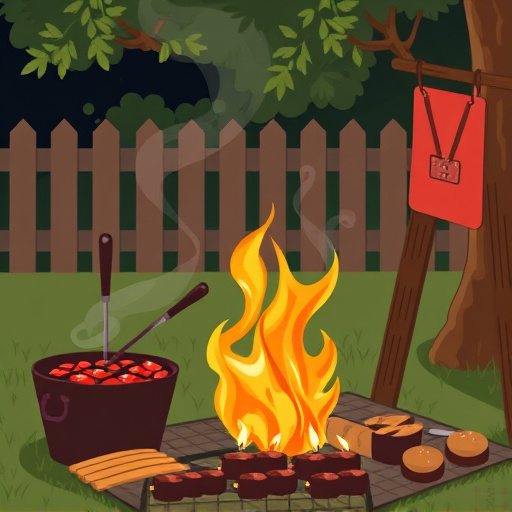To create a high-quality BBQ jerky recipe with heat, start with lean meats like beef sirloin or chicken breast. Marinate with chili powder, cayenne pepper, or hot sauce for flavor and spiciness. Brine the meat to enhance taste and prevent dryness. Cook slowly at 107°F-225°F (42°C-113°C) using a smoker or grill, experimenting with wood types for diverse flavors. Adjust cooking time based on temperature for tender jerky. Test doneness with a meat thermometer (internal temp 160°F/71°C). Store airtight in cool, dry conditions or freeze for up to six months. Enjoy as a snack or use as a topping.
Looking for a mouthwatering BBQ jerky recipe with a kick of heat? This guide covers everything from selecting the perfect meats to crafting a spicy marinade, brining for ultimate moisture, and precise smoking techniques. Learn how to control cooking time and temperature, test for doneness, store, and serve your very own fiery jerky masterpiece. Elevate your BBQ game with this delicious and addictive recipe!
- Choosing the Right Meats for BBQ Jerky with Heat
- Spicy Marinade Blend: Crafting the Kick
- The Brining Process: Moisturizing Your Jerky
- Smoking Techniques to Intensify Flavor
- Cooking Time and Temperature Control
- Testing for Doneness: Ensuring Quality Jerky
- Storage and Serving Tips for Spicy BBQ Jerky
Choosing the Right Meats for BBQ Jerky with Heat
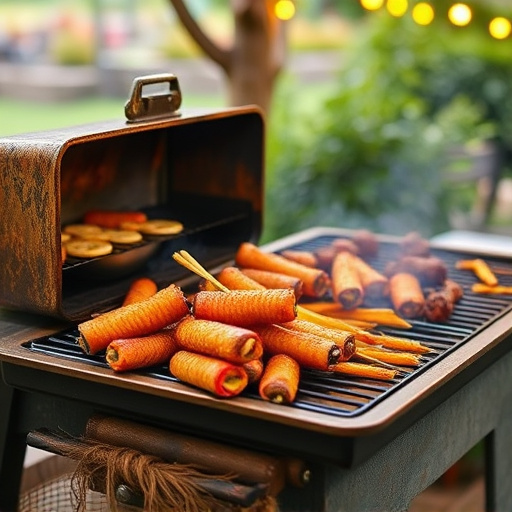
When crafting a BBQ jerky recipe with a kick of heat, selecting the right meats is paramount. Opt for lean cuts like beef sirloin or chicken breast as they tend to produce a more desirable jerky texture and are less prone to becoming too soft or chewy after drying. These cuts also allow for better control over fat content, which can influence both the flavor and shelf life of your BBQ jerky.
For that extra punch of heat, consider adding spices like chili powder, cayenne pepper, or a good quality hot sauce during the marinating process. These ingredients not only enhance the spiciness but also contribute to the overall flavor profile, transforming your ordinary BBQ jerky recipe into something extraordinary.
Spicy Marinade Blend: Crafting the Kick
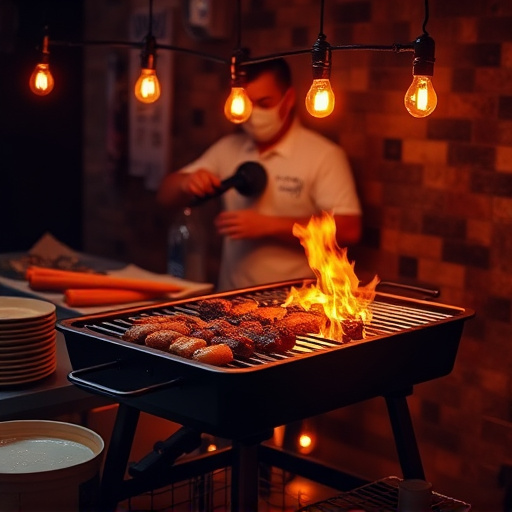
Creating a spicy marinade blend is the secret weapon for transforming your ordinary BBQ jerky into a fiery delight. This step is crucial in achieving that distinctive kick that sets your taste buds alight. The key lies in balancing the heat with other flavors, such as garlic, onions, and herbs, which add depth and richness to the final product.
Start by combining a base of olive oil or vinegar with a blend of spices like chili powder, cayenne pepper, paprika, and black peppercorns. Add finely chopped garlic and onion for an extra punch, along with dried herbs such as thyme and oregano. Adjust the spice levels to your preference—whether you desire a gentle warmth or an intense heat—by tweaking the amounts of each ingredient in the marinade.
The Brining Process: Moisturizing Your Jerky
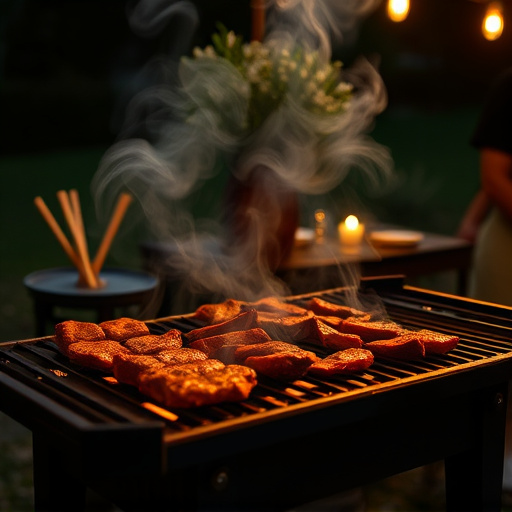
The brining process is a crucial step in creating a mouthwatering BBQ jerky recipe with a kick of heat. It involves submerging your meat slices (typically beef, turkey, or chicken) in a mixture of spices and salt water for an extended period. This method not only adds depth of flavor but also acts as a natural preservative, ensuring your jerky stays fresh longer. During brining, the salt draws moisture from the meat, creating a tender, juicy end product. The longer you brine, the softer and more flavorful the meat becomes, although be mindful not to overdo it to avoid sogginess.
Moisture is key when preparing BBQ jerky with heat. Brining effectively hydrates the meat, which is essential for maintaining its texture as it cooks. This step prevents the jerky from becoming brittle or overly dry, ensuring a satisfying crunch and chewiness that’s characteristic of good jerky. The moisture also amplifies the flavors, making each bite of your spicy BBQ jerky recipe an explosion of deliciousness.
Smoking Techniques to Intensify Flavor
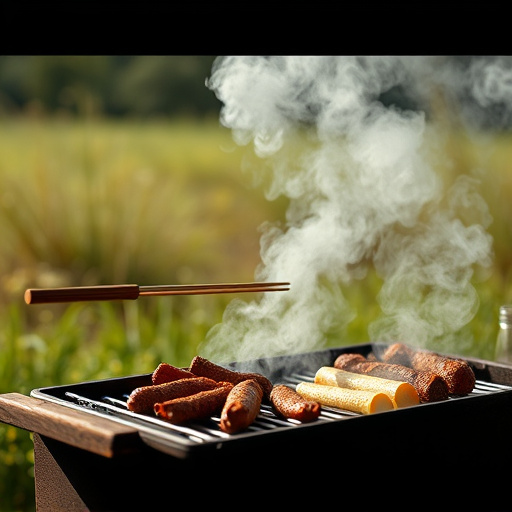
When crafting your perfect BBQ jerky recipe with a kick of heat, understanding smoking techniques is key to intensifying flavors. The art of low-and-slow cooking allows for deep, complex tastes to develop as the meat gradually breaks down. Using a smoker or grill set to a consistent temperature between 107°F and 225°F (42°C and 113°C) is fundamental. This slow process not only tenderizes the meat but also allows for the smoke to penetrate, infusing every fiber with its distinctive aroma.
Experimenting with different types of wood chips or chunks can add unique flavor profiles. Mesquite and hickory are popular choices that impart robust, smoky notes. Applewood and cherry offer a milder, sweeter taste, while pecan lends a rich, nutty flavor. Pre-soaking the wood in water for 30 minutes before adding it to your smoker can also moderate the heat and smoke intensity, allowing for more subtle flavors to shine through in your BBQ jerky recipe.
Cooking Time and Temperature Control
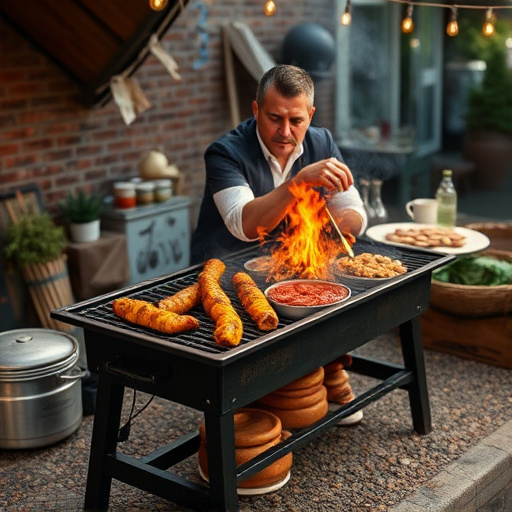
Mastering the art of cooking BBQ jerky is a delicate balance, especially when aiming for that perfect kick of heat. The key lies in understanding and controlling your cooking time and temperature. Typically, BBQ jerky recipes call for a slow-cooking process at lower temperatures, often around 160°F to 200°F (71°C to 93°C). This gentle approach ensures the meat remains tender while allowing the flavors from the marinades and spices to penetrate deeply.
Timing is critical; overcooking can lead to tough jerky, while under-cooking may result in raw patches. As a general guideline, plan for approximately 4-6 hours of cooking time, but always use a meat thermometer to ensure doneness. For that extra kick of heat, consider adding chili powder or cayenne pepper to your marinade, but remember, a little goes a long way! Adjust the spices according to your preference and taste test along the way.
Testing for Doneness: Ensuring Quality Jerky
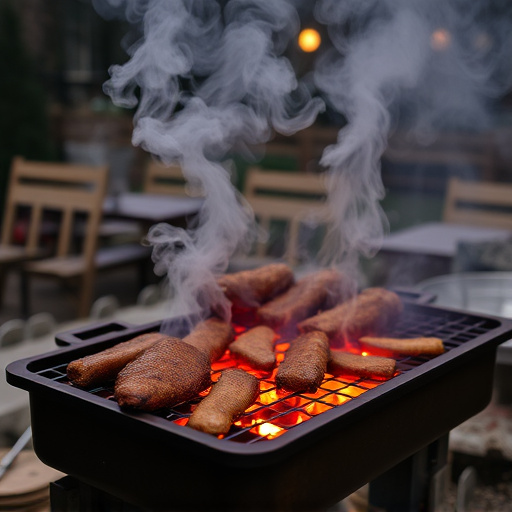
Testing for doneness is a crucial step in creating the perfect BBQ jerky recipe with a kick of heat. The ideal jerky should be lean, tender, and free from any raw or bloody spots. One surefire way to check is by using a meat thermometer; insert it into the thickest part of the meat without touching bone or fat, aiming for an internal temperature of 160°F (71°C). This ensures that all harmful bacteria have been eliminated, making your jerky safe to eat.
Additionally, jerky should be firm but not brittle. To check this, simply bend it slightly; fully cooked jerky should hold its shape without breaking or cracking. Another simple test is the tug test: gently pull on a piece of jerky; if it tears cleanly in two, it’s ready. This ensures that your BBQ jerky recipe has reached the perfect balance of flavor and texture, satisfying both your taste buds and quality standards.
Storage and Serving Tips for Spicy BBQ Jerky
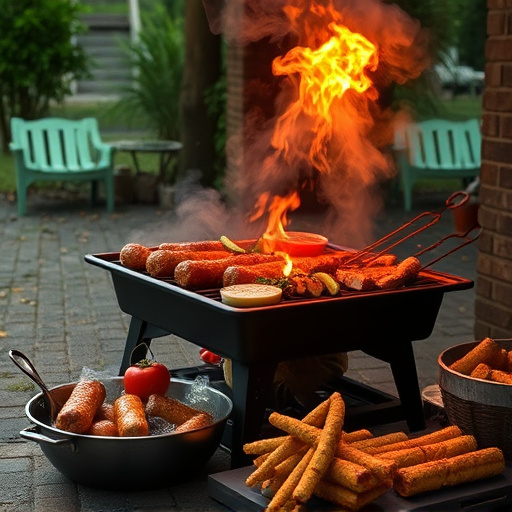
When it comes to storing your freshly made BBQ jerky recipe with a kick, consider an airtight container or a sealed bag to maintain its crispness and prevent dehydration. Keep it in a cool, dry place for up to one month. For longer-lasting jerky, freeze it for up to 6 months.
When ready to serve, take out a portion and enjoy the perfect blend of smoky BBQ flavors and heat. Pair it with your favorite beverage—a cold beer or a refreshing soda—for an indulgent snack. You can also use it as a topping for salads, sandwiches, or even pizza for an extra spicy kick in your meals.
